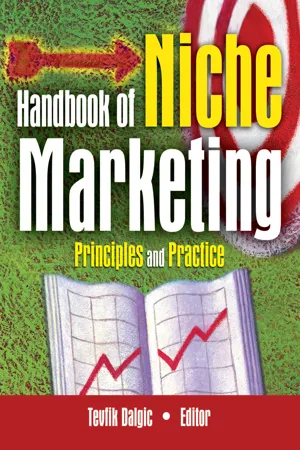Chapter 1
Niche Marketing Revisited
Concept, Applications,
and Some European Cases
Tevfik Dalgic
Maarten Leeuw
INTRODUCTION
Niche marketing is an approach which has been applied success- fully by several companies around the world. Despite its growing in- terest and increasing popularity there seems to be limited research on this subject. Although several papers have been published in this area, they are predominantly from a practitioner’s point of view. From an academic perspective research publications seem to be lim- ited to some general definitions and brief explanations, under the general heading of “segmentation” or “positioning,” in some market- ing textbooks. This chapter will attempt to bring together both the practical and conceptual aspects of niche marketing, leading to a set of guidelines which may be used as a deliberate marketing strategy. Niche marketing has been with us for some time. What is new, how- ever, is the increased diversity of markets, advanced technologies en- abling new marketing approaches, and the deterioration of large com- panies and their traditional marketing approaches. Niche marketing seems an appropriate method to be employed in this changing envi- ronment. It also seems appropriate with the unification of the present markets of the European Union and future enlargement toward the
This chapter was originally published in European Journal of Marketing (1994), Vol. 28, No. 4, pp. 39-55. Reprinted with permission.
creation of Euromarketing,1 as well as further globalization of other markets and an increase in competition among companies active in these markets.
Due to this intensification of competition a shakeout may take place in these markets, leaving only the strongest. Niche marketing may help companies to remain among the healthy survivors. Compa- nies which want to survive, grow, and be profitable may be forced to find markets which have
-
sufficient size to be potentially profitable;
-
no real competitors, or markets which have been ignored by other companies;
-
growth potential;
-
sufficient purchasing ability;
-
a need for special treatment;
-
customer goodwill; and
-
opportunities for an entrance company to exercise its superior competence. ,3
These characteristics may be termed niche characteristics. They could, however, just as well apply to a market segment. A further analysis of the differences between a segment and a niche, in the sec- tion titled Niche Marketing versus Segmentation, will clarify this is- sue. Another characteristic, according to Kotler,3 is that niches are relatively small. Although niches might be comparatively small ini- tially, they might grow to become large markets. According to McKenna,4 “most large markets evolve from niche markets.”
What Is Niche Marketing?
Target marketing, focused marketing, concentrated marketing, and micromarketing are all used as synonyms for niche marketing. Al- though they exhibit substantial similarities, they differ to some ex- tent. In this section we will not attempt to explain these differences. We will however attempt to define niche marketing. In order to do so, we have to establish the meaning of the word niche.
What Is a Niche?
Webster’s dictionary5 describes a niche as “a recessed space or hol- low, specifically a recess in a wall for a statue or the like; any position specifically adapted to its occupant.” According to the Penguin Dic- tionary of Biology,6 an ecological niche has the following meanings: a particular role or set of relationships of organisms in an ecosystem which may be filled by different species in different geographical ar- eas. Some marketers have long advocated the use of ecology or bio- logical theory in marketing in order to study markets. A relationship may be drawn between the ecological niche and the market niche.7 This refers to ecological niche and market niche similarities. In both cases, organisms and organizations live in their immediate physical environment and are able to continue their life forms in a changing environment. An ecosystem in biology may serve as an analogy for the macroenvironment of an organization which continues its life without being threatened by the environmental forces. Another defi- nition is given by Keegan et al.8 They define a niche as “a small mar- ket that is not served by competing products.” Hooley and Saunders9 use the word “pocket” to define a niche.
We consider a niche to be a small market consisting of an individ- ual customer or a small group of customers with similar characteris- tics or needs. In niche marketing a company focuses on a market niche exhibiting the aforementioned characteristics. In such market- ing we can make a distinction between two approaches:
1 To see niche marketing as a creative process, as Chalasani and Shani10 termed nichemanship, which is “a process of carving out a small part of the market whose needs are not fulfilled. By specialization along market, customer, product or marketing mix lines, a company can match the unique needs.”
2 To see niche marketing as the last stage of segmentation, taking place in the following sequential stages: segmentation, target- ing, positioning, and niching.8
A more general definition of niche marketing is provided by Stanton et al.11 as a method to meet customer needs through tailoring goods and services for small markets. Figure 1.1 depicts the develop- ment of a niche marketing strategy in support of the first approach.
NICHE MARKETING VERSUS SEGMENTATION
It is often assumed that segmentation is a starting point in niche marketing. Chalasani and Shani,10 however, hold a different view. According to them, “segmentation is the process of breaking a large market into smaller pieces. It is a top-down approach.” They further state that “niche marketing is a bottom-up approach where the mar- keter starts from the needs of a few customers and gradually builds up a larger customer base”; this is in contrast to breaking up a market into smaller markets. In this respect niche marketing may be termed as inverted or reversed segmentation. This view opposes the concept which perceives niche marketing as the last or final stage of segmen- tation.
FIGURE 1.1. Niche Building Strategy—Bottom-Up Approach
Other observed differences are that
-
a niche is usually smaller in size compared with the size of a seg- ment;
-
a niche focuses on individuals—in a segment we focus on a so- called homogeneous group; and
-
a niche fulfills a specific need in contrast to a segment where the emphasis is on being a manageable part of the market.
Kotler3 suggests that the key idea in niche marketing is specializa- tion and he provides the following ways in which to specialize:
-
end-user specialization;
-
vertical-level specialization;
-
customer-size specialization;
-
geographic specialization;
-
product or product-line specialization;
-
product-feature specialization;
-
job-shop specialization;
-
quality/price specialization;
-
service specialization; and
-
channel specialization.
Kotler’s3 idea of specialization leads us to the distinctive compe- tencies a firm needs to possess to pursue niche markets. According to Pavitt,12 innovating small firms are typically specialized in their tech- nological strategies, concentrating on product innovation in specific produced goods such as machine tools, scientific instruments, spe- cialized chemicals, and software. Their key strengths are in their abil- ity to match technology with specific customer requirements. We may conclude that niche marketing could be defined as positioning into small, profitable homogeneous market segments which have been ignored or neglected by others. This positioning is based on the integrated marketing concept and the distinctive competencies the company possesses. The previous definition addresses five essential elements of niche marketing:
- 1 positioning;
- 2 profitability;
- 3 distinctive competencies;
- 4 small market segments; and
- 5 adherence to the marketing concept.
These ideas have been incorporated within the guidelines we developed for practical application. (See Practical Guidelines, Step 1.) Other essential elements not mentioned explicitly in this definition, although included, are long-term relationships and company reputa- tion. This brings us to the concept of relationship marketing which can be defined as “a marketing strategy that seeks to establish an on- going business relationship with customers whereby the product be- comes the total relationship.”8 In niche marketing, long-term, strong relationships are key. In order to develop them, we have to practice re- lationship marketing. In this approach we try to build a relationship for the mutual benefit of both parties. Through this win-win situation the niche marketer can build a barrier to deter potential competitors and sustain long-term profitability as well as customer retention and supplier relationships.13 According to Copulsky and Wolf14 the rela- tionship marketing process incorporates three key elements:
- 1 identifying and building a database of current and potential cus- tomers,
- 2 delivering differentiated messages to these people, and
- 3 tracking each relationship to monitor the cost of acquiring the consumer and the lifetime value of his purchases.
In relation to the first element, Blattberg and Deighton15 stressed the need for a customer database in order to keep track of customer preferences and increase marketing effectiveness. They claim that “niches too small to be served profitably today will become viable as marketing efficiency improves.” Without further embarking on this process it must be clear that the central theme in relationship market- ing is that those companies which can relate to and satisfy the cus- tomer in the most comprehensive way over a period of time will sur- vive and thrive competitively. (See Practical Guidelines, Steps 2, 4, and 7.) The other concept of major importance to niche marketers is reputation. In niche marketing you do not only market your product, you also market your business; reputation is key. According to McKenna,4 “niche marketing depends on word-of-mouth references and infrastructure development, a broadening of people in related in- dustries whose opinions are crucial to the product’s success.” We may conclude that a solid reputation in the minds of the customers is es- sential to be successful as a niche marketer.
EVOLUTION OF NICHE MARKETING
General Observations
Since the 1980s mass-marketing companies have been under enor- mous pressure from niche marketers, who are nibbling away at the major markets of these mass-marketing companies. These niche mar- keters are steadily eating up parts of formerly traditional mass markets. New demands, changing customer motivations, and further individu- alization (both business-to-business as well as business-to-consumer marketing) have created a multitude of diverse and fractured markets in contrast to what once was a simple mass market. This fragmented market, also termed “multiple option society” by Naisbitt in his book Megatrends,16 is mainly technology driven. These new markets need a new nontraditional approach of marketing from these larger compa- nies in order to keep and expand their currently held markets. Ac- cording to Sheth,17 changing macroeconomic forces are reshaping marketing strategies. Consequently, doing faster and better may not be sufficient and, instead, businesses will be required to develop new marketing concepts and practices.18 American and European mass markets have been broken down into fragmented markets due to sev- eral causes since the Second World War; these causes, as identified by Linneman and Stanton,19 McKenna,4 and Rapp and Collins20 which have led to this profusion of smaller markets, are
-
single-parent households, families with double income and no children, yuppies;
-
working women, overweight people, tall people;
-
increasing minority markets;
-
technological advances;
-
the evolution of consumer countervailing power;
-
changing demographics and lifestyles;
-
the demands on personal time;
-
overcrowding by too many products, services, and stores;
-
the weakening of the magic in network television advertising;
-
the decline in brand loyalty;
-
advertising clutter, overkill, and waste; and
-
feeding the discount promotion monster.
To fulfill the d...

